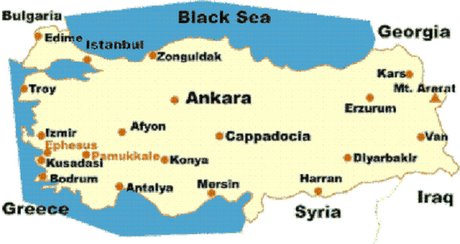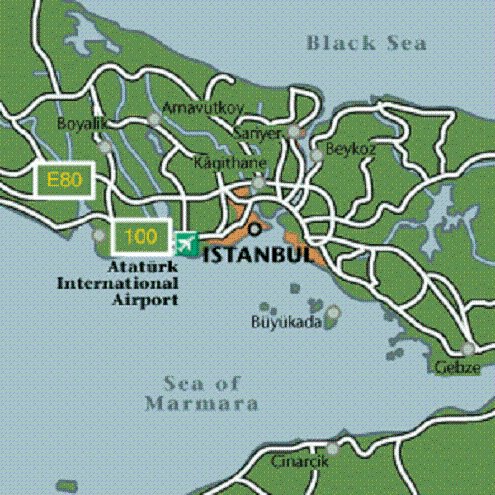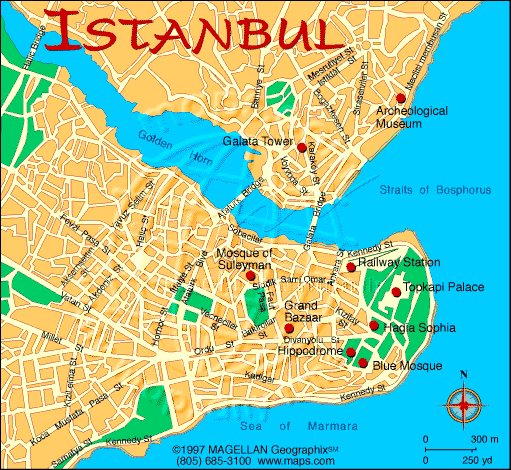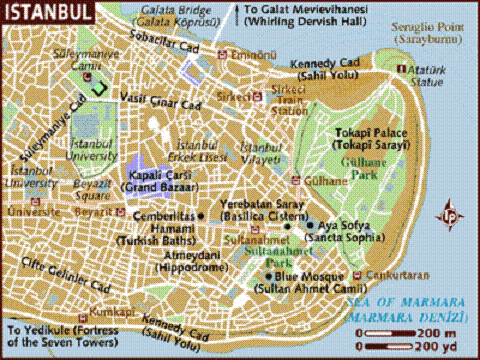Antalya-Olympos-Cirali

It is located at a distance of 75 km to the west of the Antalya provincial centre on the slope of Mount Musa and within “Olympos-Beydağları National Park” where the creek of the same name joins the sea. The name of the city is derived from “Aluamapa/Oluamapa/Olyamapa” in the Luwian/Etruscan language. In the Luwian language, “Olu”, which is a variation of “Alu”, means light/sun and in the Luwian and Hittite languages the word “Ama” means “mother”. We know that the word “Pa” means water/creek/lake. It is understood from this that the name of the city was “sacred water spring of the supreme mother of light/mother of sky”. Indeed, the spring of the Olympos creek is today called “Gökpınar” with the same association. Furthermore, in the Luwian language the word “olyntos” meant wild fig. The road monument Stadiasmus, in Patara, depicts the city of Olympos on the slope of the Mount Musa. Today’s seaside remains are found at a place named Korykos. In fact, the name Olympos has been given to all high mountains and acropolises throughout antiquity. The people of the city of Olympos on the mountain, which was within the Lycian Federation and was ruined in 75 B.C., descended to the shore and, after the final defeat of pirates by the Roman Isauricus in 78 B.C., joined the Roman lands. Maritime commerce thrived during the Roman epoch. It became the episcopal centre during the Byzantine era. The city lost its character during the Ottoman era and, owing to the floods, the people abandoned the area. South of the port, a part of the caveas and the entrance of the theatre for 8 thousand people still stand today. The theatre was used as an outdoor Orthodox basilica during the Byzantine era. Remains of the Roman Bathhouse and, on the south bank of the river, the remains of a Byzantine Church of rectagonal plan with wide arched windows can be seen. In the main necropolis to the south of the river are more than 200 inscribed tombs. As a result of recent excavations 2 sarcophagi, named Port Monumental Tombs, have been unearthed. Today the area is a favourite tourist spot, with its beach of outstanding beauty and small guest houses, restaurants, yörük style bungalows and gazebo tree houses, in character with the natural surroundings.






Little is known about the early history of Olympos, or Olimpos as it is correctly spelled in Turkish. During the second century BC it was an important Lycian city, being one of the six primary member of Lycian League. Inspired by the nearby eternal flames of the Chimaera, the Olympians worshipped Hephaistos (Vulcan) as their principal deity. The place northeast of the Ancient City of Olympos at an elevation of 250 m above the sea is known by Turks as “Yanartaş/Çıralı”. The area is called Yanartaş (Chimaera) because of the inflammable gas, which consists of a 46% hydrogen and 34% methane compound, issuing from the cracks formed as a result of the tectonic earthquakes at those places where the serpentine land and limestone rocks meet. According to mythology, Bellerophon, the son of the Luwian Lord Glaucos, desires to own Pegasus, the winged horse.
The place northeast of the Ancient City of Olympos at an elevation of 250 m above the sea is known by Turks as “Yanartaş/Çıralı”. The area is called Yanartaş (Chimaera) because of the inflammable gas, which consists of a 46% hydrogen and 34% methane compound, issuing from the cracks formed as a result of the tectonic earthquakes at those places where the serpentine land and limestone rocks meet. According to mythology, Bellerophon, the son of the Luwian Lord Glaucos, desires to own Pegasus, the winged horse.  Athena the Goddess presents him with a golden rein and tells him that when he fastens the rein on Pegasus the horse will be his. Bellerophon finds Pegasus and puts the rein over its head. So he starts flying and dominates the heavens. Bellerophon, who kills a much beloved friend of his by mistake, becomes very sad and starts wandering around the world. When the hero who helps good people comes to Finike, people “wish him to kill the monster named Chimaera, with a lion’s head, a goat’s body and a snake tail, that burns the villages around it with the fire coming from its mouth.” Bellerophon kills Chimaera with his flying horse, but cannot extinguish the fire coming out of its mouth. Thus, this is the place where the Olympos torch is fired. People organize festivities and celebrations which also lay the foundations of the olympic games in commemoration of this event. When Bellerophon wishes to go to Idyros and drink of the immortality water Pegasus, which is a clever animal, refuses to fly. When Bellerophon insists it throws him off its back. Bellerophon, having lost his horse, becomes distant from people and wanders about in seclusion until his death. The noteworthy ancient ruin in the area is the Byzantine Orthodox Basilica Complex, which contains the residencial quarters of priests, and churches. The ceremonial and reception area in the south being made of large, single piece block stones confirms the existence of the Temple of the God of Fire here. Continuing along the ancient road known as “Road of Fire”, one big and two more small fires are visible. Further up, the road branches into two, the road turning west is called the Sacred Ceremonial Way. 15 km to the east, however, Göktaş Tower is found at an altitude of 800 m.
Athena the Goddess presents him with a golden rein and tells him that when he fastens the rein on Pegasus the horse will be his. Bellerophon finds Pegasus and puts the rein over its head. So he starts flying and dominates the heavens. Bellerophon, who kills a much beloved friend of his by mistake, becomes very sad and starts wandering around the world. When the hero who helps good people comes to Finike, people “wish him to kill the monster named Chimaera, with a lion’s head, a goat’s body and a snake tail, that burns the villages around it with the fire coming from its mouth.” Bellerophon kills Chimaera with his flying horse, but cannot extinguish the fire coming out of its mouth. Thus, this is the place where the Olympos torch is fired. People organize festivities and celebrations which also lay the foundations of the olympic games in commemoration of this event. When Bellerophon wishes to go to Idyros and drink of the immortality water Pegasus, which is a clever animal, refuses to fly. When Bellerophon insists it throws him off its back. Bellerophon, having lost his horse, becomes distant from people and wanders about in seclusion until his death. The noteworthy ancient ruin in the area is the Byzantine Orthodox Basilica Complex, which contains the residencial quarters of priests, and churches. The ceremonial and reception area in the south being made of large, single piece block stones confirms the existence of the Temple of the God of Fire here. Continuing along the ancient road known as “Road of Fire”, one big and two more small fires are visible. Further up, the road branches into two, the road turning west is called the Sacred Ceremonial Way. 15 km to the east, however, Göktaş Tower is found at an altitude of 800 m.
 The place northeast of the Ancient City of Olympos at an elevation of 250 m above the sea is known by Turks as “Yanartaş/Çıralı”. The area is called Yanartaş (Chimaera) because of the inflammable gas, which consists of a 46% hydrogen and 34% methane compound, issuing from the cracks formed as a result of the tectonic earthquakes at those places where the serpentine land and limestone rocks meet. According to mythology, Bellerophon, the son of the Luwian Lord Glaucos, desires to own Pegasus, the winged horse.
The place northeast of the Ancient City of Olympos at an elevation of 250 m above the sea is known by Turks as “Yanartaş/Çıralı”. The area is called Yanartaş (Chimaera) because of the inflammable gas, which consists of a 46% hydrogen and 34% methane compound, issuing from the cracks formed as a result of the tectonic earthquakes at those places where the serpentine land and limestone rocks meet. According to mythology, Bellerophon, the son of the Luwian Lord Glaucos, desires to own Pegasus, the winged horse.  Athena the Goddess presents him with a golden rein and tells him that when he fastens the rein on Pegasus the horse will be his. Bellerophon finds Pegasus and puts the rein over its head. So he starts flying and dominates the heavens. Bellerophon, who kills a much beloved friend of his by mistake, becomes very sad and starts wandering around the world. When the hero who helps good people comes to Finike, people “wish him to kill the monster named Chimaera, with a lion’s head, a goat’s body and a snake tail, that burns the villages around it with the fire coming from its mouth.” Bellerophon kills Chimaera with his flying horse, but cannot extinguish the fire coming out of its mouth. Thus, this is the place where the Olympos torch is fired. People organize festivities and celebrations which also lay the foundations of the olympic games in commemoration of this event. When Bellerophon wishes to go to Idyros and drink of the immortality water Pegasus, which is a clever animal, refuses to fly. When Bellerophon insists it throws him off its back. Bellerophon, having lost his horse, becomes distant from people and wanders about in seclusion until his death. The noteworthy ancient ruin in the area is the Byzantine Orthodox Basilica Complex, which contains the residencial quarters of priests, and churches. The ceremonial and reception area in the south being made of large, single piece block stones confirms the existence of the Temple of the God of Fire here. Continuing along the ancient road known as “Road of Fire”, one big and two more small fires are visible. Further up, the road branches into two, the road turning west is called the Sacred Ceremonial Way. 15 km to the east, however, Göktaş Tower is found at an altitude of 800 m.
Athena the Goddess presents him with a golden rein and tells him that when he fastens the rein on Pegasus the horse will be his. Bellerophon finds Pegasus and puts the rein over its head. So he starts flying and dominates the heavens. Bellerophon, who kills a much beloved friend of his by mistake, becomes very sad and starts wandering around the world. When the hero who helps good people comes to Finike, people “wish him to kill the monster named Chimaera, with a lion’s head, a goat’s body and a snake tail, that burns the villages around it with the fire coming from its mouth.” Bellerophon kills Chimaera with his flying horse, but cannot extinguish the fire coming out of its mouth. Thus, this is the place where the Olympos torch is fired. People organize festivities and celebrations which also lay the foundations of the olympic games in commemoration of this event. When Bellerophon wishes to go to Idyros and drink of the immortality water Pegasus, which is a clever animal, refuses to fly. When Bellerophon insists it throws him off its back. Bellerophon, having lost his horse, becomes distant from people and wanders about in seclusion until his death. The noteworthy ancient ruin in the area is the Byzantine Orthodox Basilica Complex, which contains the residencial quarters of priests, and churches. The ceremonial and reception area in the south being made of large, single piece block stones confirms the existence of the Temple of the God of Fire here. Continuing along the ancient road known as “Road of Fire”, one big and two more small fires are visible. Further up, the road branches into two, the road turning west is called the Sacred Ceremonial Way. 15 km to the east, however, Göktaş Tower is found at an altitude of 800 m.







